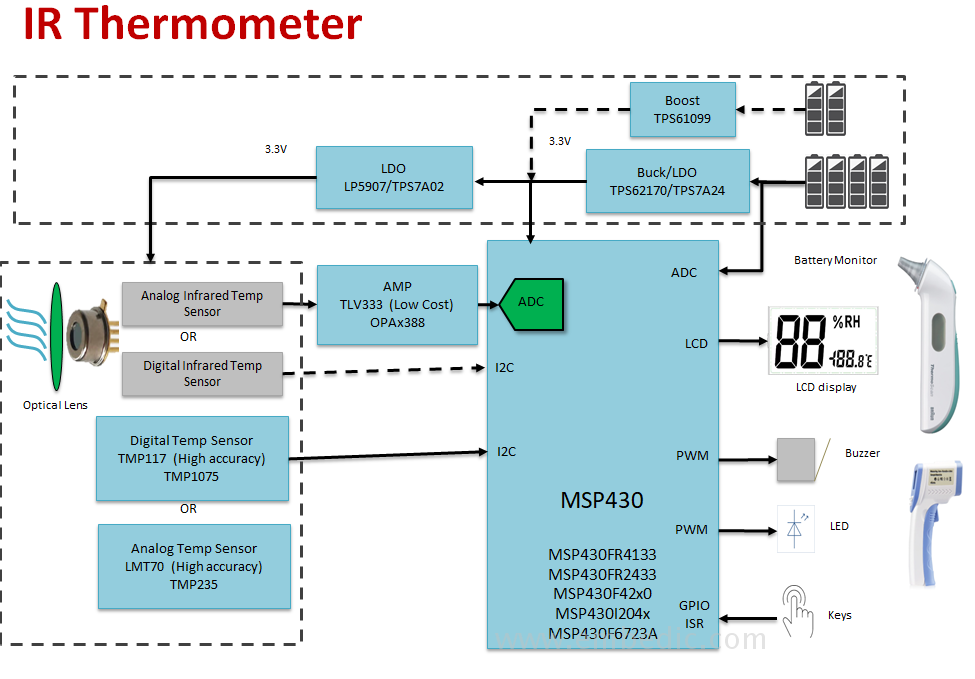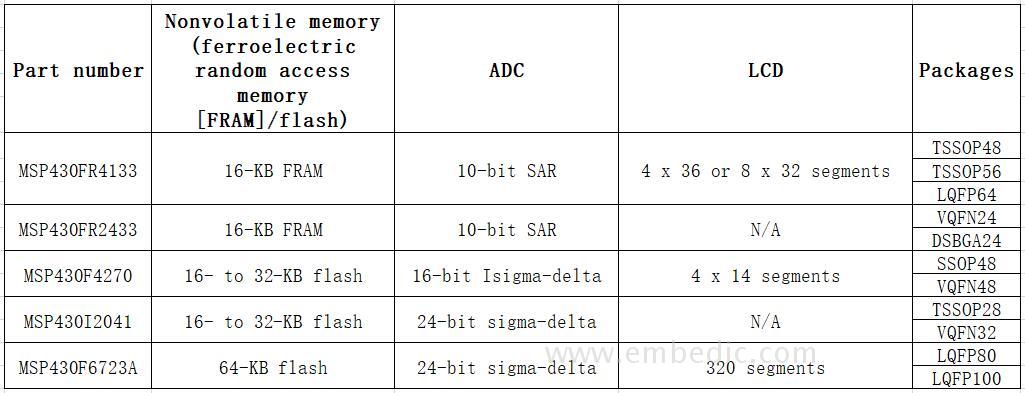Monitoring our body temperature is essential for us to stay healthy. An infrared thermometer can measure temperature without contact, which can help ease the spread of a contact infection. In this article, I’ll break down the various blocks in a system diagram of an infrared thermometer.
The MSP430™ microcontroller (MCU) is a 16-bit ultra-low-power reduced instruction set computer mixed-signal processor. Many applications are based on this product family, especially sensing and measurement applications, which benefit from having a high-performance analog-to-digital converter (ADC), LCD driver, serial communication, pulse-width modulation (PWM) output and other peripherals integrated on the device. The MSP430 MCU has become a popular choice for infrared thermometer manufacturers because it can help designers simplify the design process; develop an infrared thermometer prototype quickly; and save board space, reducing design cost.
Figure 1 is an infrared thermometer block diagram based on the MSP430 MCU and TI power-management, amplifier and temperature sensor devices.

Figure 1: A system block diagram of an infrared thermometer
Acting as the host MCU, the MSP430 MCU can provide these benefits when designing an infrared thermometer:
Table 1 lists the recommended MCUs for an infrared thermometer.

Table 1: Recommended MCUs for infrared thermometers
The design shown in Figure 1 also includes TI’s power-management, signal-chain and sensor products.
The TPS61099 is a boost DC/DC converter designed for ultra-low-power applications. The quiescent current is only 800 nA and the minimum input voltage is as low as 0.7 V, which can fully support a single-cell AA battery power supply. At the same time, it can reach 80% efficiency under an input voltage of 1.5 V and output 3.3-V fixed output / 10-µA load condition. The TPS61099 is available in adjustable- and fixed-output versions. The fixed-output version supports output voltages from 1.8 V to 5.0 V.
The TPS62170 buck converter offers low IQ that helps preserve the battery life of the system, especially while it is not in use. In addition, it supports high efficiency at above 2 MHz switching frequency to help designers decrease the size of the inductor needed, and therefore the size of the total solution.
The TLV333 operational amplifier’s ultra-low input offset voltage (15 μV) and low temperature drift (0.02 µV/°C) help minimize temperature detection errors; its rail-to-rail input/output performance helps maximize the dynamic range. A low quiescent current (28 µA), low voltage (1.8 V to 5.5 V) and small-sized packaging (SC70), combined with a working temperature range of -40°C to +125°C, make it a good fit for handheld or battery-powered medical devices. The TLV333 family is available in two (TLV2333) or four channels (TLV4333).
Some systems need a faster settling time and lower noise to help speed up temperature measurements. In these cases, consider replacing the TLV333 with the OPA388. This device’s lower offset (5 μV), lower noise (7 nV/√Hz) and faster settling time (2 μs) help minimize settling times and the number of samples required to achieve a specific temperature resolution.
TI has several operational amplifiers that can act as the signal interface between an analog sensing element and an ADC. Table 2 lists some of the amplifiers that can fit into an infrared thermometer design.

Table 2: Recommended operational amplifiers for signal interface
TI offers a wide variety of temperature sensors. The ultra-high-accuracy digital sensor (±0.1°C maximum accuracy from -20°C to 50°C) is the TMP117 digital sensor. This device has a 16-bit resolution ADC integrated in the device which communicates to a designer’s digital elements over either I2C or SMBus to ensure the best accuracy and simplest design implementation. This device is designed for battery operated systems as it has only a 150nA Iq draw when in shutdown and requires 3.5µA per 1-Hz Conversion cycle. For systems which have an integrated ADC in the MCU element, TI offers analog temperature sensors and thermistors as well. The LMT70 offers a voltage output corresponding to temperature and has a maximum accuracy of±0.13°C from 20°C to 42°C. For cost sensitive systems, the TMP61 linear thermistor offers 1% tolerance across temperature and simplifies the calibration process of using traditional NTCs.
For more cost-sensitive digital temperature sensing applications, the TMP1075 has ±1°C accuracy over a -25°C to +100°C temperature range. For systems with an integrated ADC in the MCU, analog temperature sensors such as the TMP235 and TMP236 offer a ±.5°C to ±6°C range of accuracies and gains to support design flexibility.
Providing power to the ADC and sensing elements of the design requires a low-noise, sensitive voltage rail. A low-dropout regulator (LDO) is a common choice given its ease of use and ability to provide clean, low-noise power for a sensitive analog rail. For an infrared thermometer, the TPS7A20 a good fit, given its combination of ultra-low noise (6µVRMS), high ripple rejection (85 dB at 1 kHz) and low quiescent current (6µA typical and 150 nA in shutdown mode). This LDO provides the ADC and sensing elements necessary for the low-noise rail, filtering out DC/DC ripple and contributing very little intrinsic output noise while also delivering low quiescent current for battery-powered applications, thus extending battery life.
For battery powered systems, the TPS7A02 delivers nanopower levels of IQ (25 nA, 3 nA in shutdown mode) while also providing a high power-supply rejection ratio for post DC/DC regulation. This LDO also offers excellent transient response, which is a critical need for duty-cycled loads.
Some products on the market include a Bluetooth® Low Energy communication module. To add Bluetooth Low Energy to a system, consider the CC2640R2F integrated circuit or CC2650MODA module along with SimpleLink™ software.
A load switch can reduce the current draw of components that are not always on. A device like the TPS2051 (with an integrated fault) or TPS22916 (with ultra-low leakage) can disconnect a Bluetooth Low Energy module from the battery power or any other DC rail, enabling the infrared thermometer to extend its battery life while adding additional functionalities.
The TI devices detailed in this article serve as a starting point for designers trying to quickly design an infrared thermometer. TI continues to support customers designing and building this type of end equipment by providing customer assistance, design help and support from our manufacturing sites located worldwide.
IC MCU 8BIT 64KB FLASH 100TQFP
IC MCU 8BIT 768B OTP 28SOIC
IC MCU 8BIT 3.5KB OTP 28SSOP
IC MCU 8BIT 160KB FLASH 80LQFP
1
2
3
4
5
6